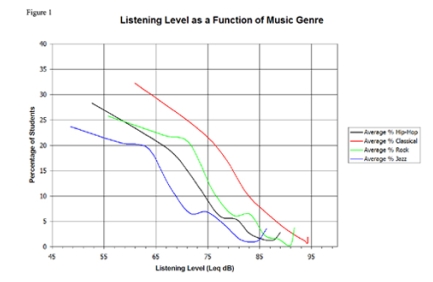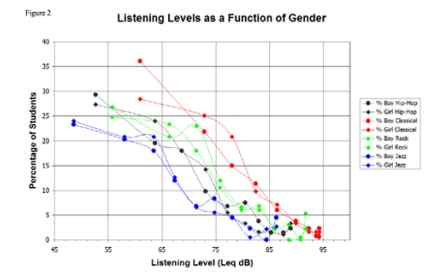Laura Warren - warr808@aol.com
Jean Warren
Dominique Cheenne
Columbia College Chicago
Des Plaines, IL
Popular version of paper 4aPP1
Presented Thursday morning, May 27, 2004
147th ASA Meeting, New York, NY
Contrary to popular belief, children are not listening to music as loud as they say they do. The majority of children admitted to feeling excited when they listen to loud music, don't like when someone tells them to turn down their music, are not nervous around it, and like their music loud.
However, my study found as the music got louder, the children became much less likely to choose to listen at a high volume.
There is sufficient evidence showing that children are damaging their hearing
at an alarmingly earlier age. Cultural norms and attitudes contribute to a desire
of vulnerable children to model what they've seen in the media and therefore
implies that they are listening to music at levels that are harmful. This study
tested a gender-balanced group of 316 elementary-aged students aimed at assessing
the correlation between the attitudes of the sample of children and their listening
levels. Findings were both surprising and encouraging, citing that a majority
of children who expressed favoritism towards loud music listened to the presented
samples at lower levels than expected. The study also proposes a set of listening
level distribution curves that may prove useful for future studies with older
participants.
Purpose
Noise-Induced Hearing Loss and Noise-Induced Hearing Threshold Shifts have become
prevalent in today's youth. Between years 1988 - 1994, 6166 children age 6 to
19 years old were tested for hearing loss in a study by the American Medical
Association (Niskar, Kieszak, Holmes, Esteban, Rubin & Brody, 1998). The
study found that 14.9% of those tested had a low or high frequency hearing loss
of at least 16 dB in one or both ears. 12.7% were found to have high-frequency
hearing loss, a type of hearing loss that is most commonly noise-induced. Furthermore,
the study also showed that a subject's demographics changed the prevalence estimate
for NITS.
According to the American Speech Language Hearing Association (or ASHA), children
with mild to moderate hearing loss often feel isolated, are without friends,
and unhappy in school. Surprisingly, this occurs more often than in children
with severe to profound hearing loss.
Children with mild to moderate hearing loss also have difficulty with all areas
of academic achievement, on the average achieve 1-4 grade levels lower than
their peers with normal hearing, and often show poor self-concept (ASHA, 2003).
With these concerns for the children in society today, it is important to start
to examine what is causing this hearing loss, and most importantly, how it can
be prevented.
In 1999, a study was performed examining the perceived loudness of a particular type of music - rock (Fucci, 1999). It found that a preference for rock music would incline a subject to say that the level they were presented with was lower than what a subject who does not prefer rock music would say.
Discussion
This study examines the factors that relate to how loud a child listens to 4
different genres of music on headphones, and ties in demographics and personal
attitudes to uncover possible correlations with a child's background, preferences,
and feelings.
The study looked at a sample of 316 students in grades 3-8 with minimum literacy
at a 3rd grade level at six suburban schools in Des Plaines, IL. The CD used
in this study contained 4 tracks of four different styles of music, including
Hip-Hop, Classical, Rock, and Jazz.
The survey administered to the students consisted of 4 demographic questions,
a music preference question, and seven attitude questions.
Out of the 316 children tested, it was found that the majority listen to hip-hop the most, with rock a close second.
Subjects felt excited when they listened to loud music. 68% of the children studied didn't agree at all with the statement "Loud music makes me nervous" and 63.9% didn't agree at all with the statement "I do not like loud music."
67.4% of the children tested answered positively to the statement "I do not like it when someone tells me to turn down the music I am listening to."
People that play loud music don't bother the children surveyed, with 58.5% of children not agreeing at all with the statement "People that play loud music make me mad (bother me)." 72.1% of children responded negatively to the statement "Kids think I am cool when I play my CD's or radio loud."
Figures 1 & 2 depict the data from the listening part of the study, and
show the four distinct listening level distribution curves.
 |
 |